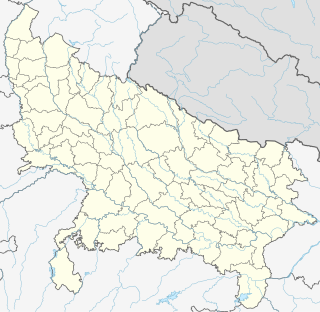Related Research Articles

The United Provinces of Agra and Oudh was a province of India under the British Raj, which existed from 1902 to 1921; the official name was shortened by the Government of India Act 1935 to United Provinces (UP), by which the province had been commonly known, and by which name it was also a province of independent India until 1950.

The North-Western Provinces was an administrative region in British India. The North-Western Provinces were established in 1836, through merging the administrative divisions of the Ceded and Conquered Provinces. In 1858, the nawab-ruled kingdom of Oudh was annexed and merged with the North-Western Provinces to form the renamed North-Western Provinces and Oudh. In 1902, this province was reorganized to form the United Provinces of Agra and Oudh. Allahabad served as its capital from 1858, when it also became the capital of India for a day.

Atrauli is a town and a municipal board in Aligarh district in the state of Uttar Pradesh, India.

Silk in the Indian subcontinent is a luxury good. In India, about 97% of the raw mulberry silk is produced in the Indian states of Karnataka, Andhra Pradesh, Tamil Nadu and West Bengal. Mysore and North Bangalore, the upcoming site of a US$20 million "Silk City", contribute to a majority of silk production. Another emerging silk producer is Tamil Nadu where mulberry cultivation is concentrated in Salem, Erode and Dharmapuri districts. Hyderabad, Andhra Pradesh and Gobichettipalayam, Tamil Nadu were the first locations to have automated silk reeling units.

The Culture of Uttar Pradesh is an Indian Culture which has its roots in the Hindi and Urdu literature, music, fine arts, drama and cinema. Lucknow, the capital of Uttar Pradesh, has several beautiful historical monuments such as Bara Imambara and Chhota Imambara. It has also preserved the damaged complex of the Oudh-period British Resident's quarters, which are being restored.

The United Provinces of British India, more commonly known as the United Provinces, was a province of British India, which came into existence on 3 January 1921 as a result of the renaming of the United Provinces of Agra and Oudh. It corresponded approximately to the combined regions of the present-day Indian states of Uttar Pradesh and Uttarakhand. It ceased to exist on 1 April 1937 when it was renamed as the United Provinces. Lucknow became its capital some time after 1921. Nainital is the summer capital of the province.
Maulaheri Jats is a family of Jats that derives its name from the village of Maulaheri, situated on the banks of the Hindon River, in the district of Muzaffarnagar in western Uttar Pradesh. The Maulaheri Jats were the most prominent family of Jat landlords in western Uttar Pradesh. To quote The Imperial Gazetteer of India 1901- Gazetteer of Muzaffarnagar, "The chief Jat landholder in the district is Chaudhri Ghasiram, the son of Chaudhri Jawahir Singh of Maulaheri in tahsil Muzaffarnagar. He is the head of the great family of Maulaheri Jats, and owns twelve villages, paying a revenue of Rs. 9736. Of these six lie in Baghra, three in Muzaffarnagar, two in Khatauli and one in Bhuma Sambalhera."

The Emblem of Uttar Pradesh is the official seal of the government of the Indian state of Uttar Pradesh. The emblem was originally designed in 1916 for the then United Provinces of Agra and Oudh and continued in use following Indian Independence in 1947.

Khes is a thin cotton blanket cloth of the Indian subcontinent; it is a damask cloth used for blankets and winter wraps. Khes is generally hand-woven with coarse cotton yarns. Khes as a garment is a simple clothing item to wear loosely to cover upper body parts by men in Pakistan and Punjab, India. Khes is an important cloth of Punjab region, a region which is famous for its production and historically has been known for not only the production of Khes but also many other coarse cotton textiles, especially in the 19th and 20th centuries. Khes is a comfort object used in bedding, and also usable as a cover.

Piece goods were the textile materials sold in cut pieces as per the buyer's specification. The piece goods were either cut from a fabric roll or produced with a certain length, also called yard goods. Various textiles such as cotton, wool, silk, etc., were traded in terms of piece goods. The prices were determined as per the fabric quality.
Gulbadan was a kind of striped silk produced in Hindustan. The gulbadan was a light textured cloth of silk and cotton. Gulbadan has vertical variegated stripes with a different color than the base color of the cloth. In appearance, it was similar to a glazed calico, unlike Mashru, which has the satin (lustrous) surface.The contemporary silk piece goods were Daryai and Dhupehan. Gulbadan was available in many color combinations and sizes. Gulbadan of Amritsar and Lahore were famous. "Sufi" was another name for Gulbadan striped fabric.
Dosuti was one of the coarser cotton piece goods produced in the Indian subcontinent. Originally, it was a handspun and handloom cloth made in the villages. Punjab was having various cotton qualities during the 19th century. All were distinguished with their weight, thickness, and the yarn. Dosuti was a cloth made by running two yarns in warp and weft as its name refers to Do(double) Suti. India's Eastern side was famous for more delicate cotton materials such as Dacca muslins, and Punjab and Gujarat were famous for coarser cotton textile piece goods. Dosuti was a thick cotton material used for rough usages, such as duster. The other contemporary cotton products were Eksuti, Tinsuti, and Chausuti, etc.
Gaji is a coarse cloth mainly made with cotton or silk, used for native dresses in India.
Dorea was a type of striped or check patterned cloth made in the Indian subcontinent. The continued striped Dorea was a simplest form of Dorea.

Saidpur Behta is a village in Bachhrawan block of Rae Bareli district, Uttar Pradesh, India. As of 2011, its population is 612, in 118households. It historically belonged to the taluqdars of Tirbediganj.

Behta Kalan is a village in Lalganj block of Rae Bareli district, Uttar Pradesh, India. It is located 8km from Lalganj, the block and tehsil headquarters, a bit to the north of the road connecting it and Rae Bareli, the district headquarters.

Gaura Hardo, or just Gaura, is a village in Rae Bareli district, Uttar Pradesh, India. It serves as the headquarters of Deenshah Gaura block, in the tehsil of Dalmau. It is located 33km from Raebareli, the district headquarters, on the road from Dalmau to Salon. As of 2011, Gaura Hardo has a population of 8,001 people, in 1,446 households. It has five primary schools and one maternity and child welfare centre.

Jalalpur Dhai is a village in Deenshah Gaura block of Rae Bareli district, Uttar Pradesh, India. It is located a short distance north of the Ganges, on the road from Dalmau to Mustafabad. As of 2011, it has a population of 5,520 people, in 966 households. It has one primary school and no healthcare facilities. Jalalpur Dhai hosts markets twice per week, on Wednesdays and Sundays, with cloth and vegetables being the main items traded.
Sangi was a kind of silk produced in Hindustan. It was a mixed woven cloth, a common cloth in the nineteenth century. The fabric was constructed with a cotton warp and a silk weft, or vice versa.
Daryayi was an old silk fabric. It could have gotten its name from the fabric's wavy or striped pattern, like a Darya, which means river. Daryayi silk was made in Meerut and Lucknow until the late eighteenth century by weavers known as daryayi baff. These weavers, most likely migrated to India from Central Asia, a well-known silk-weaving region between the Syr and Amu Darya rivers. This twelve-inch-wide fabric comes in a range of colors like red, yellow, blue, green, and white. Daryayi was used as a patka in Hindu wedding ceremonies, or as a border for women's clothing.
References
- 1 2 3 4 5 6 7 A Monograph on Silk Fabrics Produced in the Northwestern Provinces and Oudh. Printed at the N.-W. Provinces and Oudh Government Press. 1900. p. 91.
- ↑ Shakespear, John (1834). A Dictionary Hindustani and English. Kokil & Company. p. 1242.
- ↑ Pradesh (India), Uttar (1989). Uttar Pradesh District Gazetteers: Azamgarh. Government of Uttar Pradesh. p. 97.
- ↑ Oudh (India), United Provinces of Agra and (1911). District Gazetteers of the United Provinces of Agra and Oudh: Azamgarh. Supdt., Government Press, United Provinces. p. 62.
- ↑ Guha, Research School of Pacific Studies Ranajit (1988). Selected Subaltern Studies. OUP USA. p. 90. ISBN 978-0-19-505289-3.
- ↑ Oudh (India), United Provinces of Agra and (1922). Report on the Industrial Survey of the United Provinces: Basti district. 1923. Azamgarh district. 1923. Gorakhpur district. 1924. Superintendent, Government Press, U.P. pp. 15, 18.
- ↑ Economic and Political Weekly. Sameeksha Trust. 1983. p. 142.